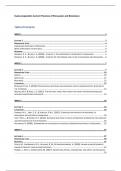Samenvatting
Summary Exam preparation Current Theories of Persuasion and Resistance
- Instelling
- Radboud Universiteit Nijmegen (RU)
This course summary involves everything discussed during the lectures of the course Current Theories of Persuasion and Resistance of the Master's Communicatiewetenschap at the Radboud University. It also involves concise summaries of the mandatory readings for the course. These notes helped me pass...
[Meer zien]




